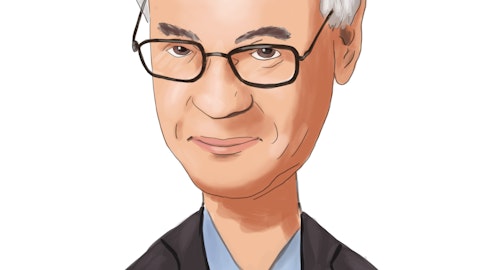Premier Financial Corp. (NASDAQ:PFC) Q4 2022 Earnings Call Transcript January 25, 2023
Operator: Good morning, and welcome to the Premier Financial Corp. Fourth Quarter 2022 Earnings Conference Call. All participants will be in a listen-only mode. After today’s presentation, there will be an opportunity to ask questions. Please note this event is being recorded. I would now like to turn the conference over to Paul Nungester from Premier Financial Corp. Please go ahead.
Paul Nungester: Thank you. Good morning, everyone, and thank you for joining us for today’s fourth quarter 2022 earnings conference call. This call is also being webcast, and the audio replay will be available at the Premier Financial Corp. website at premierfincorp.com. Following our prepared comments on the company’s strategy and performance, we will be available to take your questions. Before we begin, I’d like to remind you that during the conference call today, including during the question-and-answer period, you may hear forward-looking statements related to future financial results and business operations for Premier Financial Corp. Actual results may differ materially from management forecasts and projections as a result of factors over which the company has no control.
Information on these risk factors and additional information on forward-looking statements are included in the news release and in the company’s reports on file with the Securities and Exchange Commission. And now I’ll turn the call over to Gary for his opening comments.
Gary Small: Thank you, Paul, and good morning to everyone. We really appreciate you joining us today. Just as a comment, as we begin, I want to acknowledge that Matt Garrity, a gentleman who’s been a participant on this call for a number of years, will not be with us this morning. Matt has accepted a role as CEO at a very fine institution over in Western Massachusetts. And I wanted to take a moment to thank him for all these contributed to us over the years. It’s very much appreciated, and we wish him well as new endeavor. Last evening, we reported net income for the quarter of $25.3 million or $0.71 a share with full earnings for the year, topping $102 million, or $2.85 a share. The fourth quarter saw a continuation of the theme for Premier in 2022.
Strong loan and deposit growth driving net interest income, tempered by higher growth-related loan loss provisions and a weakened residential lending environment. In addition, Q4 expenses underperformed uncharacteristically for the organization this quarter. For the year, loans were up 20%. Deposits are up 7.7% and net interest income was strong. Through the three first quarters of the year, excuse me, the first three quarters of the year, deposit pricing lagged very purposefully and margins expanded. The fourth quarter results reflect higher repricing velocity in select deposit portfolios along with an increase in noncore funding, and thus, the margin has retracted. The Fed’s actions over the third and fourth quarters have elevated our clients’ deposit pricing expectations.
And when combined with our increased utilization of noncore funding sources, our total cost of funds are likely to remain elevated in the near term. Beta management has never been more important. We’ve made meaningful strides in repricing our most elastic deposit business lines to ensure deposit retention and in support of growing our deposit base in ’23, and Paul will have much more on this topic shortly. Overall loan growth for the quarter was up $239 million. That’s 15% on an annualized basis. That ran a little hotter than we had telegraphed at the end of the third quarter. Commercial growth was up just shy of 13%. The higher-than-anticipated loan growth triggered a hike in our loan provision figures for the quarter as well as it has all year as is a seasonal impact on such growth.
Full year total loan growth totaled $1.17 billion, with the commercial growth of 20%. Consumer was up 26%, and residential mortgage growth came in at 25%. The new money commercial commitments were $1.75 billion for the year. Obviously, a very big year for the team and good momentum going forward and a nice combination of business to both existing and new clients. Our C&I originations totaled 41% in the fourth quarter, and it continues to be a primary focus for our commercial team, while line utilization remains under 40% because our clients are utilizing their cash on hand. Residential mortgage originations for the quarter came in at about $200 million and $1 billion for the year. That’s about 75% of the expectation we had when we entered 2022 when the year looks so different.
Difficult market — a difficult market and a challenging environment to be selling to the Fannie and Freddie network. Our gain on sale continues to underperform historical levels in terms of basis points. Swings in residential construction hedges valuations unfavorably impacted fourth quarter revenue as falling residential rate environment in November actually negated a positive hedge position that we recorded in the third quarter. And so net-net, the two quarters combined, the right number got posted, but it certainly had an unfavorable impact on the fourth quarter alone, and we estimate it to be about $0.04 So think of that as timing within the two quarters. 12/31 delinquency was 74 basis points, and that’s very much in line with the performance over the course of the year.
Net charge-off trends remain very low. We had 1.5 basis points of net charge-offs for the year when you exclude a large charge-offs that we took in the midyear that we had specifically reserved for in 2021. Nonperforming loans were down 4% versus the third quarter. So Paul, I’ll give it over to you for more details.

Photo by Sean Pollock on Unsplash
Paul Nungester: Thank you, Gary. I’ll summarize some of our fourth quarter and full year results, beginning with the balance sheet growth. Total loans, including those held for sale, increased by $239 million during the quarter, representing a 15% annualized growth or 20.5% year-over-year growth. As Gary mentioned, growth occurred in all categories, including commercial, residential and consumer. Deposit growth was also healthy where we added $100 million of customer deposits in the quarter or 6% annualized growth or almost 8% year-over-year. Noninterest-bearing deposits led the way with over 9% annualized growth in the quarter, while interest-bearing deposits grew almost 5% annualized. Due to loan growth outpacing deposit growth, creating a continued reliance on higher cost FHLB and an accelerated deposit beta, we did experience some compression of net interest income and margin during 4Q.
Excluding PPP and marks, loan yields increased 27 basis points to 4.51% and total interest-earning asset yield increased 31 basis points to 4.21%. These represented betas of 18% and 22%, respectively, compared to the increase in the average effective Federal Funds rate for the quarter. Deposit costs, excluding marks and broker deposits, increased 34 basis points to 0.72% for a 22% beta in the quarter. However, total cost of funds, excluding marks but including broker deposits and floating rate borrowings increased 41 basis points to 0.97% for a 28% beta. The increase in cost of funds in excess of the increase in our earning — interest-earning asset yield less than the margin compression for 4Q. On a full year basis, net interest income increased $15 million or almost 7% on a tax equivalent basis and $29 million or 14% on a core basis, excluding PPP and marks.
Net interest margin also increased 4 basis points to 3.28% on a core basis. Next, noninterest income of $14.2 million for 4Q was down $2.5 million from the prior quarter primarily due to mortgage banking. Mortgage banking income decreased $4.3 million on a linked-quarter basis due to a $4.6 million decrease in gains offset slightly by $300,000 higher MSR valuation gains. This was primarily driven by hedge fluctuations. In prior quarters, our hedges increased in value as rates increased and mortgage prices decreased, and the reverse occurred in 4Q at an accelerated pace such that our prior hedge gains were effectively eliminated. As a result, the cumulative net hedging as a wash, but the individual quarters can be volatile once corrections occur like in 4Q.
Security gains were $1.2 million in 4Q, primarily from $1.3 million of gains on the sale of $8.7 million of equity securities which were partially offset by $100,000 of decreased valuations on our remaining unsold equity securities. We also sold $9.6 million of available-for-sale securities for a minor gain and the combined $18.3 million of proceeds from security sales will benefit net interest income beginning in the first quarter of 2023. On a full year basis, noninterest income declined $17 million with $5 million from security gains and $12 million from mortgage banking, which decreased due to lower production, saleable mix and margins. Expenses of $43 million were up 4.7% on a linked-quarter basis partly from further lower deferred costs related to the lower quarterly residential mortgage loan production as well as higher health care benefit costs that increased in 4Q after positive trends in the prior two quarters.
On a full year basis, expenses increased $7 million or 4.6%, primarily due to compensation and benefits, which increased due to higher staffing levels for our growth initiatives and higher base compensation for annual increases plus one year adjustments that we mentioned previously. The allowance increased $2.2 million in 4Q due to $3 million of provision expense for loan growth, offset partially by $830,000 of charge-offs. Our asset quality stacks remained solid during the quarter with annual decreases for nonperforming loans and classified loans of 30% and 37%, respectively. At December 31, our allowance coverage of nonperforming loans was 215%. Finishing the balance sheet of capital with a quarterly increase primarily due to earnings in excess of dividends and an $8 million positive valuation adjustment on the available-for-sale securities portfolio.
At December 31, our tangible equity ratio was 6.78%, an increase of 11 basis points from 9/30 and excluding AOCI, TE would still be approximately 9% at 12/31, consistent with 9/30. Additionally, our regulatory ratios remain comfortably in excess of well-capitalized guidelines with Tier 1 capital at approximately 10.1% and total capital at approximately 11.9% on a consolidated basis at 12/31. That completes my financial review, and I’ll now turn the call over to Gary for some additional remarks.
Gary Small: Thanks again, Paul. I’ll share a few thoughts on our financial performance expectations for ’23 as is our norm. Expect point-to-point earning asset growth of a more modest 5% or so, plus or minus, in ’23. Average balance growth will benefit from the very strong ’22 growth trajectory we’ve experienced. Pipelines entering ’23 a bit lighter as you might expect. Deposit growth will be in line with the balance sheet growth. And our core net interest income, excluding PPP grew $29 million in ’22 versus ’21, and that same momentum and trajectory will be a benefit to us in ’23. We have a bit more margin uncertainty in the first six months of the year. We think we could see movement in either direction to some degree until things settle down with the Fed and customer expectations.
We do have 50 bps of Fed turns cooked into our plan for the upcoming year. Provision for growth and modest net charge-offs meet our expectations. No meaningful movement and unemployment is expected, which would affect potentially the provision expense. No material change in the residential mortgage fee income contribution in ’23 versus ’22, we’re going to assume it continues to be a soft market. Noninterest income otherwise will range between 3% and 5% up. We have the typical cost containment measures, and we expect 3.5% or so year-over-year. We continue to support our digital bank enhancement program for this year, which is our mobile and online offering. And this year also, ’23 will include the annualized effect as the midyear salary year readjustments we made in ’22.
So 3.5% is an aggressive number. For ’22 as a whole, we were up 4.6%, which I think would be a bit higher than we had anticipated, but well within the environment and what we’re seeing with peer organizations. Our efficiency ratio targeted for ’23 is just a hair over 53% and we do have positive operating leverage when we adjust ’22 for the PPP and security gains impact. So we’ve given you a lot to work with there. And I’m ready to turn it over for questions.
See also 11 Most Undervalued Natural Gas Stocks To Buy and 10 Biggest HVAC Companies in the US.
Q&A Session
Follow Premier Financial Corp (NASDAQ:PFC)
Follow Premier Financial Corp (NASDAQ:PFC)
Operator: And our first question today goes to Brendan Nosal of Piper Sandler. Brendan, please go ahead. Your line is open.
Brendan Nosal: Hi, good morning, guys. How’re you?
Gary Small: Good morning.
Paul Nungester: Good morning, Brendan.
Brendan Nosal: Just to start on the mortgage piece I want to make sure I kind of interpreted your commentary right. It sounds like the sum of the past two quarters is kind of the right run rate going forward. Does that kind of imply like roughly $1.5 million to start the year in total mortgage banking income on a quarterly basis?
Paul Nungester: I think we were a little north of $6 million for the year. I think we’re closer to $8 million, like $2 million a quarter.
Gary Small: That would include the servicing income along with the normal gain on sale. That’s why it was so the answer there. The $6.5 million might mean the gain on sale, but overall fee income would be $8.5 million. Your point on the hedge activity kind of overstated Q3 and with the rate movement that if it hadn’t occurred, we’d still be sitting on it, but the rate movement did the offset in Q4. So that’s the mismatch.
Brendan Nosal: Okay. Understood. Understood. And then maybe one more for me before I step back. Certainly, we hear your comments, Gary, on kind of margin sounds like plus or minus from here depending on the variety slightly better influencing things. I mean, what gives you confidence that we won’t see another quarter or two of compression of this magnitude in the fourth quarter?
Gary Small: Well, and Paul can share some details. We have dug into the product portfolios and the business portfolios as we’ve gone through our pricing strategy in response to some of that higher demand and asked some of our clients as well as our intent to raise new money in the market. And we’ve really find very managed betas in our consumer book, the majority of our business book and so forth. And we’ve isolated all of our efforts around wealth management and certain segments of our business clients, where we see that elasticity and the competition really being fierce. And we have at this point, I’ll take wealth management book as an example, that’s a money market book of about $0.5 billion. We have repriced 75% of that book.
So I guess if I would leave you with anything, I’m not sure everybody has got to that point yet, but they will. But that was one — we’re wanting to raise deposits. The first thing was, let’s not unintentionally lose deposits by dragging our feet too long in that book. But that gives you some indication of where we’ve been very busy in getting repriced and so we don’t have that to deal within the next six months. So there’s that. And I think we’ve isolated the other portfolios to understand the elasticity and we feel pretty comfortable that we will be able to continue to sort of slow place some rate increases as we launch or the competition elsewhere. Paul, anything you would add there?
Paul Nungester: No, you pretty much hit it. I mean, included in the business would be about funds. And those would have higher betas traditionally than some of the other buckets, partly just due to the product mix, like a STAR Ohio product.
Gary Small: Yes. And that’s the obvious one. I mean, we do have pricing that’s linked to the Federal Home Loan Bank. So to the extent the Fed is not going to do 225 basis points of movement in a quarter, then ’23 would be a little bit more stable relative to that large funding source as well.
Brendan Nosal: Okay, all right. Thank you for the color. I appreciate it.


